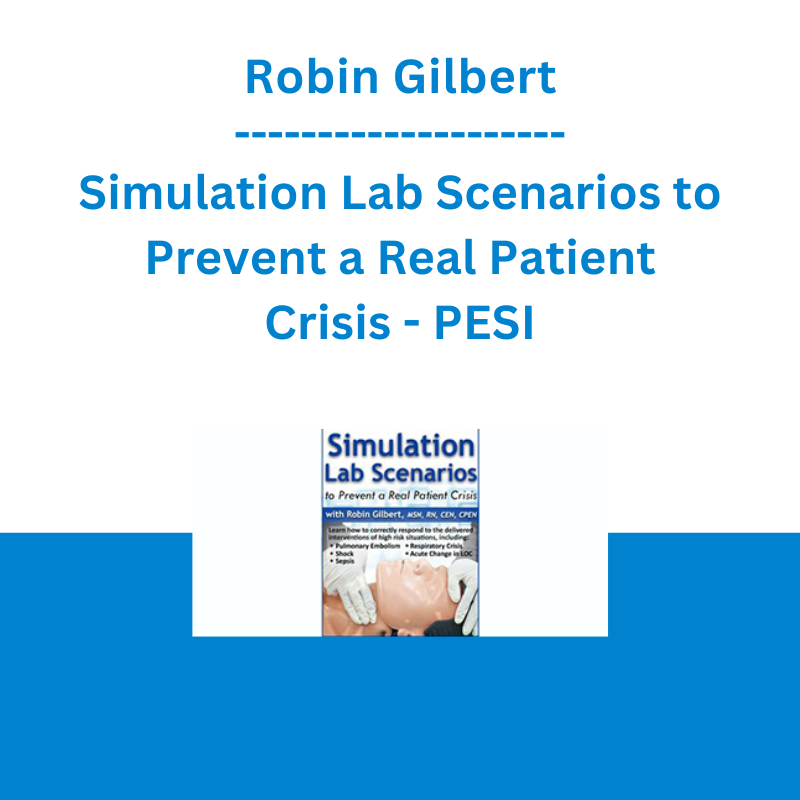*** Proof of Product ***
Exploring the Essential Features of “Robin Gilbert – Simulation Lab Scenarios to Prevent a Real Patient Crisis – PESI”
Simulation Lab Scenarios to Prevent a Real Patient Crisis
Speaker: Robin Gilbert, MSN, RN, CEN, CPEN
Duration: 1 Hour 31 Minutes
Format: Audio and Video
Description
Robin Gilbert, MSN, RN, CEN, CPEN will use simulation scenarios to identify patients whose condition is deteriorating, the appropriate interventions, and desired outcomes. Simulation provides a non-threatening approach to high-risk scenarios that will ultimately improve patient safety. The realism of simulation can improve failure to rescue situations in actual patient care. During the scenarios, the mannequins will respond based on the interventions delivered for a variety of high risk situations, including:
- Pulmonary Embolism
- Shock
- Sepsis
- Respiratory Crisis
- Acute Change in LOC
Viewing this simulation will allow you to think through the action you might plan to take for the patient and further reflect on her best practice recommendations and rationale that follow. Virtual simulation is self-paced to allow for personal assessment of strengths and weaknesses. Learning through simulation scenarios provides immediate feedback, in a safe environment, which builds confidence and provides an excellent bridge to real-life patient care situations.
Speaker
Robin Gilbert, MSN, RN, CEN, CPEN
Robin Gilbert, MSN, RN, CEN, CPEN, has over 25 years of experience in emergency nursing. She is both a certified emergency nurse and a certified pediatric emergency nurse. Robin has extensive experience working in the emergency department, progressive care, intermediate care, transitional care, step-down and, currently, as the regional manager for staff development at Central Maine Medical Center. Robin draws on her expertise to teach her own hospital staff and experienced healthcare audiences throughout the country on a variety of critical care and emergency nursing topics.
She has been an item writer for the Board Certification of Emergency Nursing (BCEN), a former Chairperson of BCEN, and most recently a contributing writer for the current CEN Review Manual. Robin is an active member of the Emergency Nurses Association, the American Nurses Association, Society of Critical Care Medicine, Association for Nursing Professional Development, and is a reviewer for the ANCC’s Pathway to Excellence.
Speaker Disclosures:
Financial: Robin Gilbert has employment relationships with EBSCO, Central Maine Medical Center, Rumford Hospital, Pathway to Excellence, and Kaplan University. She receives a speaking honorarium and recording royalties from PESI, Inc. She has no relevant financial relationships with ineligible organizations.
Non-financial: Robin Gilbert is a member of the Society of Critical Care Medicine, the American Association of Cardiovascular and Pulmonary Rehabilitation, and the Emergency Nurses Association.
Target Audience
Nurses, Nurse Practitioners, Clinical Nurse Specialists, Nurse Educators
Objectives
- Explore signs and symptoms of Pulmonary embolism
- Exploit differential diagnoses that present with respiratory distress
- Communicate use of anticoagulants and other treatment options
- Breakdown signs and symptoms of shock
- Separate obstructive shock from hypovolemic shock
- Determine appropriate interventions for obstructive shock
- Determine potential causes for changes in LOC
- Communicate DKA and treatment
- Dissect risk factors for sepsis
Outline
- Scenario 1
- Skills
- Cardiac monitoring
- O2
- IV access
- ACLS algorithm
- Skills
- Scenario 2
- Skills
- IV access
- Needle decompression
- Chest tube set-up
- Skills
- Scenario 3
- Skills
- Cardiac monitor
- IV
- Intubation
- Insulin drip
- Skills
- Debriefings
- Team approach
- Closed loop communication
- Risk for errors
Please see the full list of alternative group-buy courses available here: https://lunacourse.com/shop/









